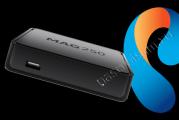A little about adsl
If it is reasonable to explain that it sounds like that. ADSL decrypts as ASYMMETRIC Digital Subscriber Line - asymmetric digital subscriber line, ie Data Transmission Line is not uniform, incoming traffic exceeds the traffic outgoing (for example 500/8000 Mbps or 800/10000 Mbps). Transmission of data on the ADSL technonic data is implemented through a normal analog telephone line using a subscriber device - ADSL modem and access multiplexer (DSL Access Multiplexer - DSLAM) (DSL Access Multiplexer - DSLAM) (DSL Access Multiplexer - DSLA (from where the phone goes PBX itself. As a result, there is a channel without restrictions on the inherent telephone network, DSLAM multiplexes a plurality of DSL subscriber lines into one high-speed trunk network.
The usual telephone line uses the frequency band of 0.3 ... 3.4 kHz. In order not to interfere with the use of the telephone network for its intended purpose, in the ADSL, the lower limit of the frequency range is at the level of 26 kHz. The upper limit, based on the requirements for the data transfer speed and the capabilities of the telephone cable, is 1.1 MHz. This bandwidth is divided into two parts - frequencies from 26 kHz to 138 kHz is assigned to the outgoing data stream, and the frequencies of 138 kHz to 1.1 MHz - incoming. The frequency band from 26 kHz to 1.1 MHz was not chosen by chance. In this range, the attenuation coefficient is almost independent of the frequency.
This frequency separation allows you to talk on the phone without interrupting the Internet operation along the same line. To divide the line to the phone and DSL line in the subscriber's apartment, the low frequency filter is set (Spliter frequency separator), which transmits only a low-frequency compidant signal to phones and eliminating the possible effect of telephones on line. If several phones are installed in the apartment, then all of them must be connected after the spliter. It is also not allowed to install ADSL if the subscriber has previously worked the phone through the block, i.e. Spray with another machine.

The transfer to the subscriber is carried out at speeds up to 8 Mbps, but there is a standard ADSL2 and ADSL2 + in which the data transfer rate can reach up to 12 Mbps and up to 24 Mbps, respectively. In ADSL systems, 25% of the total speed is assigned to ADSL systems. Unlike ADSL2, where the number of service bits in the frame may vary from 5.12% to 25%. The maximum line speed depends on a number of factors, such as line length, section and specific cable resistance. Also, a significant contribution to the increase in speed makes the fact that a twisted pair is recommended for the ADSL line, and not the TRP (noodles).
ADSL2 contains many innovations aimed at urching productivity, network interaction, speed adaptation and much more. ADSL2 + doubles the bandwidth of information reception, reaching 20 Mbps speed on telephone lines of 1500 meters long. But for normal operation, the line does not proper to get used to 2000 meters. If you have the Internet running on the ADSL line, and this line is extended more than 2 km, then do not expect a stable Internet from it. In general, if you still have an IPTV service in addition to the ADSL, then the ADSL2 + modulation and the speed required for the stable operation of both services are used - from 15 Mbps to 19 Mbit / s.
Frequency Diphane for ADSL2 and ADSL2 +

The subscriber telephone line, when used for techno, the ADSL must have the following parameters:
Signal attenuation (Line Attenuation)
up to 20 dB - excellent line
from 20-40 dB - working line
from 40-50 dB - rejeckless failures, breakdowns are possible
from 50-60 dB - the signal disappears
Noise level (RMS Noise Energy (dB relative to 1 MW with load resistance 600 ohms)):
from -65 DBM to -51 DBM - Excellent line
from -50 DBM to -36 DBM - good line
from -35 DBM to 20 DBM - Bad Line
Signal ratio noise (Signal-to-Noise-Ratio SNR)
up to 20 dB - excellent line
from 20 dB to 10 dB - good line
from 10 dB to 7 dB - may fail
from 6 dB and below - the work is not possible!
In general, the line parameters depend on what settings put the provider on the ADSL port on the DSLAM. The larger the data transfer rate of topics the line parameters deteriorate, but it acts more from those subscribers who have no distance from the PBX more than 1500 meters.
In major cities, ADSL is added to faster access technologies - Ethernet (FTTB), GPON (FTTH). Fast Ethernet - up to 100 Mbps, Gigabit Ethernet - up to 1 Gbps, 10gits / s Epon - up to 10 Gb / s. Despite the emergence of faster data transmission methods, ADSL technology remains the leader in the broadband data transfer market. In a number of European countries, ADSL is the standard de facto when providing fast enough and inexpensive inetrnet. So in Finland, where every resident of the country is legislation from June 2010. Warranty Internet access is guaranteed, the connection of most houses will apply exactly using the ADSL technology, a British Telecom covered by 2013 services using ADSL2 technology + 90% of the UK territory.
Read 6149 time





